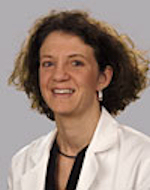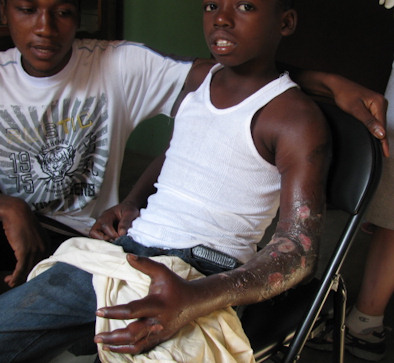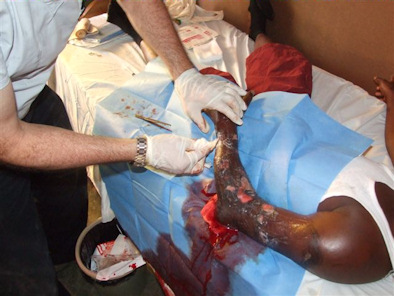The Cutting Edge of Medical Technology Content, Community & Collaboration
As reported in Aunt Minnie ...

Dr. Gia Deangelis, a radiologist from the University of Virginia in Charlottesville, was supposed to be in Port-au-Prince the day the quake struck. She is now working in a rural clinic in Grison-Garde, north of the decimated capital of Port-au-Prince. Here are her observations about the situation in Grison-Garde and Cap-Haitien, located on the north coast of Haiti, one of the cities people from Port-au-Prince are now coming to in search of food and medical help.
I arrived in Haiti a few days after the earthquake, as part of a previously planned trip to provide pediatric services to our long-established medical clinic in rural Grison-Garde (one hour south of Cap-Haitien), as part of a Haiti mission for a local church group. I practice pediatrics as part of this group.
In August, I served as a consultant for Doctors Without Borders (Médecins Sans Frontières), teaching ultrasound at Maternité Solidarité, a 75-bed hospital they built to provide dedicated emergency obstetrical care in Port-au-Prince. Similar to all hospitals in Port-au-Prince, it has been badly damaged, and pregnant mothers and newborns have been evacuated...
... Because Haiti was centralized with Port-au-Prince as its hub, the rest of Haiti was dependent on the operation of the capital city. The banks are indefinitely closed and cash cannot be obtained easily. Cellular phone and Internet service have been affected; hence, communication is difficult everywhere in the country. In Port-au-Prince, many of the wounded were not able to reach available medical aid because of poor communications.
The impact of the earthquake on Cap-Haitien is significantly greater than I initially imagined. The second largest city in Haiti and 200 miles by road to the north, Cap-Haitien, was not hit as hard by the earthquake as Port-au-Prince, but it had immediate loss of communication and electricity. A critical fuel shortage followed shortly afterward.
To get here, our own plane had to refuel in the Bahamas because Cap-Haitien was out of fuel. Electricity and communication have now been restored in Cap-Haitien, although resources are becoming critical as people flood into this relatively poor city from Port-au-Prince.
We're in the middle of this mess in many respects. On top of all that has already happened, another earthquake just occurred today (January 20) (magnitude 6), and we felt those tremors here.
Justinian Hospital, the public hospital in Cap-Haitien, has seen a large influx of injured from Port-au-Prince because there were no functioning hospitals there immediately after the earthquake. Many of the patients coming from Port-au-Prince didn't come with resources...
... Some significantly injured people have come to Justinian Hospital -- either by personal means or via the buses the mayor of Cap-Haitien has set up to bring supplies to Port-au-Prince and to return with injured. Port-au-Prince is overwhelmed with untreated injuries. Most injuries are orthopedic-related, with many compound fractures and traumatic amputations. The crucial steps of washing the wounds and at least aligning the fractures have been done and IV antibiotics given. Many are now waiting for more definitive orthopedic repair.
 |
| This boy was one of only six survivors out of approximately 600 students in a school that collapsed in Petionville, Port-au-Prince. His parents perished in the quake. He heard about our clinic and, like others, came here. All photos courtesy of Dr. Gia Deangelis. |
 |
The boy shown in the images above had his arm trapped under concrete for almost two days. The demarcation on his shoulder indicates where the edge of the concrete was and the skin excoriation resultant from the crush, pressure, and edema. The boy needed wound care for his crush injury, and we saw him every day this week and have follow-up care by one of our colleagues, Eugene Maklin, a Haitian physician here.
We gave him rocephin IM plus oral antibiotics. The swelling improved somewhat, although the elbow seemed more indurated and swollen. We aspirated purulent blood with an 18-gauge needle and then opened and drained the joint in the clinic. There were not a lot of other options for hospitals, but the case is likely adequate for management ... Justinian Hospital, the public hospital in Cap-Haitien, is overwhelmed with patients waiting to be seen. The beds are mainly occupied by those with more serious injuries including open fractures...
... The Cap-Haitien airport is Haiti's second main airport, and entrance to and from Haiti for relief efforts is not as limited as it is in Port-au-Prince. Buses and car transport between these two cities is accessible and takes only a few hours. Aid is coming in through Cap-Haitien by air and the port.
Peggy Ramsey, the owner of Bimini Island Air (the airline we use), has made her flights available for flying in medical equipment. The greatest need at many of the hospitals is actually getting equipment, and less so with personnel ... Some of the big items that we need include orthopedic equipment; the need is very great. Drugs like Lovenox (which prevents clotting) are also high on the list...
AuntMinnie.com contributing writer
January 22, 2010
------------------------------
Read on at: http://www.auntminnie.com/index.asp?Sec=sup&Sub=ped&Pag=dis...
CC
Views: 10
© 2025 Created by CC-Conrad Clyburn-MedForeSight.
Powered by
![]()